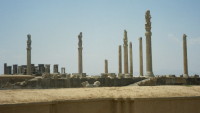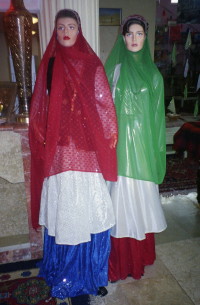
Photo. The magnificent palace complex at Persepolis, Iran.
This wonder of the world
was founded by Darius the Great around 518 BC, although more than a century
passed before it was finally completed.
Other
archaeological discoveries at Haft-Tappeh in Khuzestan
Province indicate
that women used to wear lipstick, rouge, and eye makeup in 2000 B.C. in
Iran.
Achaemenid era religious texts say that the wives of the king spent a lot of
time applying makeup and perfume before meeting the king. The ancient Greeks
admired the Achaemenid era Persians for their custom of wearing makeup and
attributed the origin of the use of cosmetics to the East.
Advanced make
up
Already at that
time makeup was used in an advanced way for perfection of the human beauty.
Iranians used several different types and styles of makeup in the Achaemenid,
the Parthian, and the Sassanid eras (according to Tehran Times). Seven items
were used in women's cosmetics in ancient
Iran: sormeh (black powder used as eyeliner), henna to dye the
hair and hands, qazeh (rouge powder for the cheeks), sefidab (powder to whiten
the face), vasmeh (powder to darken and thicken the eyebrows), zarak (yellowish
powder used to lighten the hair colour), and khal (a beauty spot).
|
********************************
Advertising
******************************* |
Contact us in Travel Explorations for
booking your tour to Iran.
E-mail: Stein@TravelExplorations.com
Soon we will introduce our partner in
Iran! |
The symbolic in number
seven (7)
The number seven
symbolised perfection in ancient Zoroastrian traditions and the number twelve
symbolised virtue. Cosmetics were common in ancient,
Iran but only married women were allowed to wear
makeup. The style of makeup was also different than the style in the Islamic
era.
|
Photo. Dolls display Iranian
women dressed up in their beautiful traditional clothes.
Texts by Avicenna and Al-Biruni were the first Iranian sources
describing women's use of cosmetics.
In his book "Social History of Iran", Ravandi quotes Avicenna and
Al-Biruni as saying that women wore makeup to improve their beauty. As he
wrote: "Many things were used to
add to women's beauty and there was no limitation in the
use of cosmetics". |
 |
So for they who
think it's feminine to use cosmetic, you should be beware of that in ancient
times in Iran, men
also used cosmetics. As mentioned used Darius the Great used black eyeliner.
Also the famous Parthian commander Sorena wore makeup, and he used it regularly.
Do you like to wear it as
Darius the Great, or not?
Is the eyeliner
you use too harsh as Darius the Great used? If you don't like the sharpness of
your eyeliner, you can soften it using your eye shadow brush by adding a little
powder shadow of a similar shade, and don't forget to smile. Don't use too much,
so might be you looking like a Christmas Three. Use your change
now to get beauty tips from ancient time. Today's makeup is actually a
very affordable way to maintain your beauty and enhance those areas, which you
feel, need special attention or focus. So perhaps why
not use a beauty spot as they used in ancient time?
Perhaps we can learn
something from the Old Persians? But anyway I think that a real friendly smile
is the best way to improve a humans` beauty, and I can
not think of a friendlier
people than the Iranians. They are a real beautiful people.
Stein Morten Lund,
13 November
2004
Additional
information
Source:
Tehran Times:
http://www.tehrantimes.com/advsearch.asp
Bookings -
presentation of our partner in
Iran:
Coming soon! In
the mean time we give you exciting travel information based on own experiences
and a wide range of reliable sources. You are also welcome to contact us for
tour suggestions, prices and advise on e-mail stein@TravelExploratins.com.
Read more
about use of cosmetic in ancient time in Persia (Iran):
Iranian Cultural
Heritage News Agency (CHN): http://www.chn.ir/english.
Here you find
some direct links to more information about cosmetic in ancient
Iran -
Iranian Cultural Heritage News Agency (CHN):
Cosmetics, Styles &
Beauty Concepts in Iran
Use of cosmetics
is documented from around 10,000 BC, however the bulk of our information comes
from around 3000 BC and from the written records of the ancient Mesopotamian and
Egyptian texts and artefacts. These ancient people were a lot more at ease with
their body and sexuality compared to the later periods. Both males and females
used make up, had long or short hair as they desired, wore jewellery, coloured
their body parts and dressed elaborately and colourfully. Men had
no problems wearing skirts and fashion and style was
not as yet used to emphasis marked gender differences, however it
distinguished class and status.
Body was used
freely and sexuality was often perceived as a gift from gods and was celebrated.
Judging by the number of nude male and female attendants and personalities
depicted, nudity did not seem to be a problem.
However high-ranking females would not expose their bodies as
much as ordinary females did as a sign of high status. Scented oils and
ointments were used by this time to clean and soften the skin and mask the body
odour. Dyes and natural paint was used to colour the face, mainly for ceremonial
and religious occasions. Rich people applied minerals to their faces, skin
(Iranians use roshoor) and used oiled-based perfumes in their bath
..Read more
on: http://www.chn.ir/english/eshownews.asp?no=3661
How Iranian Women Applied
Makeup 3000 Years Ago
To describe how
Iranian women applied makeup many thousand years ago is a difficult task. To say
that how female cave dwellers used to array and beautify themselves within the
geographical sphere now
known as Iran, is not easy and the answer to
such a question can be found only by a few archaeological excavations and rare
records unearthed from ancient times. From a few records survived from such a
time it is evident that not only women but men also
used to apply cosmetics and that their makeup stemmed from religious beliefs
rather than beautification ends.
Archaeological
discoveries dating back to about 10 thousand years ago in several caves such as
the Kamarband Cave, the Hooto Cave (in Mazandaran) and Behistun Cave in
Kermanshah show that women and men used the bones and teeth of hunted animals
and even colourful stones to beautify themselves. Thus, the remains of animal
horns, colourful stones and the skins and shells of aquatic species such as
bivalves point to the first human makeup material in Iran.
Exploration and research in Iveh and Gol plains in Bakhtiari region (the heart
of Zagros mountainous range), has also led to
a series of evidences
.Read more on http://www.chn.ir/english/eshownews.asp?no=3864
